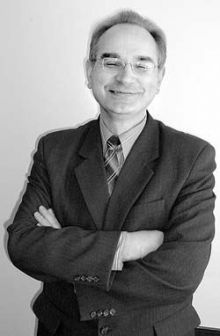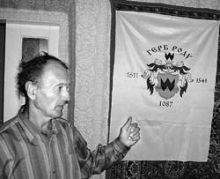Ukrainians who are more or less well-versed in history must have heard of Subotiv, a small village in Cherkasy oblast, which was the family estate of Bohdan Khmelnytsky. It is one of the many tiny villages that became great by force of history. But Subotiv has some counterparts that were not as lucky. One of them is the village of Vyhiv, located in Korosten district, Zhytomyr oblast, where the family tree of Hetman Ivan Vyhovsky took root.
Today Vyhiv is a tiny village lost in the forests of Polissia. There isn’t even a sign indicating that a traveler is approaching its outskirts. Still, an attentive and knowledgeable traveler would never bypass this settlement. There is a small monument on a hill in the village center, from where you can see the surrounding areas. A black granite pedestal supports a bronze bust of a knight wearing a Cossack hat and a well turned-out mustache. The inscription reads, “Ivan Vyhovsky, Hetman of Ukraine.” This Cossack leader, successor to Bohdan Khmelnytsky, was born here in Vyhiv in the early 17th century. His family name is derived from the village name, and most of its current residents also bear this surname.
I went into the post office right behind the monument and asked the postmaster where the Vyhovskys live. “The Vyhovskys are all over the village, and my name is Liudmyla Vyhovska, too!” the lady laughs in reply.
In Soviet times very few Vyhiv residents ever recalled their famous countryman: his name was only mentioned in combination with such epithets as “traitor,” “Polish henchman,” etc. Soviet ideologists could not forgive the hetman his rejection of the Treaty of Pereyaslav and the 1658 agreement with Poland (Treaty of Hadiache), or Vyhovsky’s brilliant victory over the Russian army in 1659 near Konotop. It was not until Ukraine became independent that Ivan Vyhovsky was finally recognized as an outstanding statesman and his fellow countrymen began showing an interest in the hetman’s life story.
The local school teacher, Leonid Melnychenko, is the most competent local authority on Vyhovsky. Also born in Vyhiv, he now resides in the neighboring village of Poliske. “I am also a Vyhovsky on my mother’s side,” Melnychenko says, pointing to the Vyhovsky family’s coat of arms hanging on the wall. “I began researching the history of my native village and the life of Hetman Vyhovsky 10 or 12 years ago. The material I’ve gathered is enough for a monograph. I’ve already begun to write one.” The researcher says that during the 16th and 17th centuries hundreds of nobles lived in the surrounding villages. While the Zaporozhian Sich may be described as the cradle of the Cossacks’ art of war, Vyhiv was the “forge” in which leaders of the Hetmanate were tempered. In addition to Ivan Vyhovsky, this village produced dozens of his noble relatives, who constituted the ruling elite of the 17th-century Cossack state. Moreover, the village was the center of the Vyhiv region, which comprised several villages and farmsteads.
Melnychenko has been painstakingly tracing the history of his native village. He is in touch with archives in Ukraine and Russia and participates in specialized historical conferences. Through his archival work the researcher has found Hetman Vyhovsky’s direct descendants now living in Western Europe. But he hasn’t shown all his cards yet. “All in good time. Ukraine is about to learn what a prominent figure Hetman Vyhovsky was,” Melnychenko says.
Most of Melnychenko’s fellow villagers consider him an oddball, but he just cannot sit around doing nothing. Teaching drawing and physical education in school, this determined man also finds time to paint large canvases (he is a graduate of Lviv’s Institute of Decorative and Applied Art). His paintings — seascapes and landscapes in a riot of colours — are strikingly beautiful. But for the time being, this beauty lies gathering dust in the basement of the local school. Neither the painter nor the village council have funds to open a gallery, a lifelong dream of Melnychenko’s.
Collecting antiques is another one of his hobbies. As a result of numerous visits to far-flung villages (“the heart of the Vyhiv land”), he has amassed a collection of domestic items that would do an ethnographic museum proud. Hundreds of these antiques line the corridors of the school’s workshops, which serve as makeshift exhibition halls: cast-iron pots, bast shoes, and a loom. Melnychenko bought these things and brought them to the school at his own expense. “Three times I asked the directors of the Zhytomyr Ethnographic Museum to come and see these treasures. But they don’t come,” the amateur ethnographer says sadly. In spite of everything, he fanatically persists in gleaning the history of his native Vyhiv.
Nowadays, two-thirds of the village residents (around 200) bear the name of their glorious countryman. The Vyhovsky name pops up 12 times in the lists of registered pupils. Even though the teachers, many of whom are also named Vyhovsky, they never mix up their pupils.
I go into the first courtyard on the central street and shout, “Do the Vyhovskys live here?” A man, a woman, and a boy around 12 years old come out of the house. “We are the Vyhovskys,” says the head of the family. We introduce ourselves. The husband is a radio technician and the wife is a postal carrier. “We’ve spent our whole life in Vyhiv,” 52-year-old Viktor says. “Thirty years ago there was nothing but Vyhovskys in all the neighboring villages! Whenever I visited my relatives in other districts, they would say respectfully, ‘Oh, a Vyhovsky has come!’ Now there are fewer Vyhovskys: the old people have died, and the young ones have gone away. But those who have stayed remember their noble roots. I think Hetman Ivan Vyhovsky is my ancestor. How could it be otherwise!”
I asked about the origins of this glorious and popular name. “According to one theory, it came from an exclamation,” says Nina, Viktor’s wife, “A long time ago people would call to each other: ‘Hey, vy! Hov’ [Hey, you! Ho!] So it became Vy-hov.”
Three years ago, owing to the efforts of the indefatigable Melnychenko, as well as Cossacks from the Polissian Sich and various sponsors, including some businessmen named Vyhovsky, a monument to their outstanding fellow countryman was erected in the village. Melnychenko dreams that one day Vyhiv will become a “second Subotiv.” “My associates and I have formed a civic committee and are trying to turn Vyhiv into a museum complex dedicated to Ivan Vyhovsky,” the researcher says emotionally. “There is a program for developing Vyhiv. The monument is just the first step. This is an historic village that deserves the government’s attention, for it was, and still is, the home of unique people.”
However, today Vyhiv cannot boast of its erstwhile nobility. The village is in a slow decline. It now has a population of 340, a little over half of its former size. A third of the houses stand desolate. The residents still hope that the village does not die out completely. In any case, what these people still have is hope that things will get better, and a noble name — one name for everyone.









